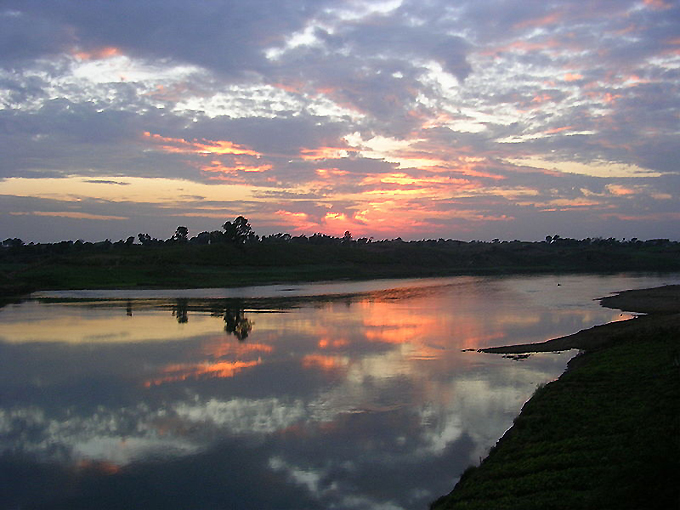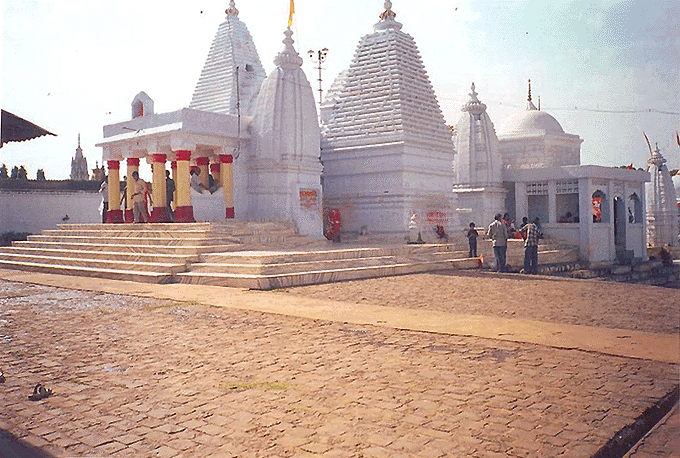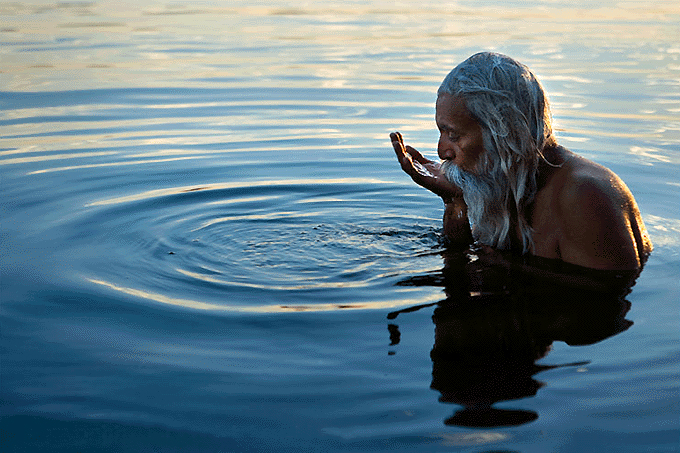
|
|
|
|
BY: SUN STAFF

Jhansi Ghat – the Narmada River at Jabalpur Mar 30, CANADA (SUN) — A serial exploration of the holy sites visited by Lord Caitanya. Narmada-tira
We began our work on today's segment, featuring Lord Caitanya's visit to Narmada-tira, in the usual way -- by searching the online Vedabase. At the start of Sri Caitanya-caritamrta Madhya Lila chapter nine we find the following Summary written by HDG Srila Bhaktivinoda Thakur. This description is taken from his Amrta-pravaha-bhasya, a commentary in Bengali (1895) on Krsna dasa Kaviraja's Sri Caitanya-caritamrta:
Madhya 9 Summary "At Pandarapura the Lord received news from Sri Ranga Puri that Sankararanya (Visvarupa) had disappeared there. He then went to the banks of the Krsna-venva River, where He collected from among the Vaisnava brahmanas a book written by Bilvamangala Thakura, Sri Krsna-karnamrta. The Lord then visited Tapi, Mahismati-pura, the Narmada River and Rsyamuka-parvata." When one clicks on the term 'Narmada', which is hyperlinked in the Vedabase, we come to a reference page with these items:
But where is the reference to Mahaprabhu's visit to the Narmada River? Well, it's not there. The original Sanskrit term provided by Srila Bhaktivinoda Thakur in his Amrta-pravaha-bhasya says something different: In order to find Narmada-tira in the current Vedabase, one would have to search for narmadara tire ("on the bank of the river Narmada; CC Madhya 9.310). One might also happen across the term tira, for which the Vedabase includes various citations, although Narmada-tira is not among them. The Sanskrit terms tira or tire refer to 'the banks of a river', i.e., the riverside, or shore. But according to the new edited version of Madhya Lila 9, the focus in the chapter Summary is now on the river itself, not on the banks of the river. Perhaps the BBT editors had a mistaken conception that Lord Caitanya's pastimes took place in the Narmada River, rather than on the river's banks, and they felt that Thakur Bhaktivinoda's designation 'tira' had nothing to tell us. If that had been the case, of course, Srila Bhaktivinoda would not have used the term tira. He might have instead used the term veni, or a similar word meaning 'river'. This is confirmed later in the article, in the example given from Madhya Lila 9.310. In his Amrta-pravaha-bhasya, which Srila Prabhupada chose to include in the Summary of his Caitanya-caritamrta, Srila Bhaktivinoda used tira, and as we have seen in previous segments of this series that discussed, for example, Kaveri-tira, Tamraparni-tira, or Payasvini-tira, the difference can be significant. For example, the importance of Lord Caitanya's pastimes with Ramananda Raya at Godavari-tira – on the banks of the Godavari – would not be as accurately described by simply referring to the Godavari River where He also took bath. Bathing in the river is not the same as sitting on the riverbank. We see further evidence of this distinction in Srimad-Bhagavatam 5.19.17-18, in which the Narmada is included in a long list of sacred rivers. The term tira is not used, because the sloka refers to the bodies of moving water, the rivers, not to a stationary place along a river's banks. So for our part, we conclude that by changing narmada-tira to Narmada River, the BBT editors have eliminated a nuance that had importance, and they have thus done more harm than good. Although we intended to focus this segment on the glories of Caitanya Mahaprabhu's pastimes at Narmada-tira, we'll take this opportunity to continue our exploration of the importance of terminology regarding holy rivers. In fact, the many sastric references to the Narmada provide us with a wealth of information that reveals the sacred nature of this river visited by Lord Caitanya. We not only find references to the significance of India's river theerthams, we also find the specific qualities of the holy Narmada River and the transcendental personalities who've associated with it. Further, we discover the many important nuances of meaning contained in the terms used to describe the Narmada River, and in the contextual references. Let us begin with Srimad-Bhagavatam 5.17.1. This sloka describes how Vamanadeva pierced a hole in the covering of the universe with the nail of His big toe. Through the hole, the pure water of the Causal Ocean entered, as the Ganges River. In his purport, Srila Prabhupada emphasizes the importance of living on the banks of such a holy river:

Temples at Narmada-kund Srimad-Bhagavatam 5.17.1 Purport "In this verse, Sukadeva Gosvami describes the glories of the Ganges River. The water of the Ganges is called patita-pavani, the deliverer of all sinful living beings. It is a proven fact that a person who regularly bathes in the Ganges is purified both externally and internally. Externally his body becomes immune to all kinds of disease, and internally he gradually develops a devotional attitude toward the Supreme Personality of Godhead. Throughout India, many thousands of people live on the banks of the Ganges, and by regularly bathing in her waters, they are undoubtedly being purified both spiritually and materially. Many sages, including Sankaracarya, have composed prayers in praise of the Ganges, and the land of India itself has become glorious because such rivers as the Ganges, Yamuna, Godavari, Kaveri, Krsna and Narmada flow there. Anyone living on the land adjacent to these rivers is naturally advanced in spiritual consciousness." Srila Prabhupada specifically mentions the Narmada as one of the holy rivers akin to the Ganges. And here we find the differentiation between, for example, tira and veni: one can live on the banks (tira) of a holy river such as the Narmada, engaging in fruitive activities, or one can take bath in the river (veni), and be purified. In the next verse from Srimad-Bhagavatam 6.10.15 we find another important point of differentiation regarding the Narmada River. In this case, the Sanskrit term used to describe the banks of the Narmada is narmadayam rather than narmada-tira, and a distinction is made between the river in India, and the transcendental, celestial Narmada: Srimad-Bhagavatam 6.10.16
SYNONYMS TRANSLATION PURPORT The next example refers specifically to Lord Caitanya's visit to the Narmada. This sloka specifically describes the fact that Lord Caitanya's pastimes took place on the banks of the Naramada – not in its waters. The Sanskrit clearly states this: narmadara tire. This fact is further distinguished by the reference to the Tapi River, in which the Lord bathed. The sloka says tapi snana kari -- bathed in the Tapi. The sloka does not say tapi-tire, because it is referring to the Lord's pastimes in the water, not on the banks. Madhya 9.310 strongly supports our above mentioned opinion, that the BBT editors have erred in changing Srila Bhaktivinoda Thakur's words, eliminating the qualifying descriptor narmada-tira, and changing it to a place name, Narmada River. Caitanya-caritamrta Madhya Lila 9.310
SYNONYMS TRANSLATION PURPORT

Narmada River at Omkareshwar In the following sloka we find a concise description of sacred rivers like the Ganges or Narmada as being auspicious places where the Deity is worshipped. In this case, there is a differentiation between where the river flows (padam, the place), the qualities of the river (nadyah, sacred), and the activities conducted on the banks of such a river, like deity worship (arca). Srimad-Bhagavatam 7.14.29
SYNONYMS TRANSLATION Following is another pointed example of the importance of specificity in describing the river and its banks. In this case, the Narmada River is described as narmadayah, the bank of the river is described as tate, and the bank is further described as being the northern bank, uttare: Srimad-Bhagavatam 8.18.21
SYNONYMS TRANSLATION In the following two verses from Bhagavatam, we find another interesting example of terminology, this time precisely differentiating between a particular river (the Reva, or Narmada), being in the water of the river (reva-ambhasi, the flow of the water (rurodha saritam, the directionality of the flow (pratisrotah), and the banks of the river (sarit-jalaih). Srimad-Bhagavatam 9.15.20-21
SYNONYMS TRANSLATION SYNONYMS TRANSLATION Finally, in Chapter 79 of Krsna Book, Srila Prabhupada specifically states that Lord Balarama visited the Narmada River, and His pastimes took place on the bank of the river. It's interesting to note that although the sloka from Srimad Bhagavatam 10.79.19-21 which refers to this pastime does not differentiate between the river bank or the river's water, in Krsna Book, Srila Prabhupada mentions twice the river bank, thus giving it obvious emphasis. Krsna Book, Chapter 79 "From Cape Comorin Lord Balarama turned toward Kerala. The country of Kerala is still existing in southern India under the name of South Kerala. After visiting this place, He came to Gokarna-tirtha, where Lord Siva is constantly worshiped. Balarama then visited the temple of Aryadevi, which is completely surrounded by water. From that island, He went on to a place known as Surparaka. After this He bathed in the rivers known as Tapi, Payosni, and Nirvindhya, and then He came to the forest known as Dandakaranya. This is the same Dandakaranya forest where Lord Ramacandra lived while in exile. Lord Balarama next came to the bank of the river Narmada, the biggest river in central India. On the bank of this sacred Narmada there is a pilgrimage spot known as Mahismati-puri. After bathing there, according to regulative principles, Lord Balarama returned to Prabhasa-tirtha, wherefrom He had began His journey." All these examples serve to underscore the point that every shade of description in sastra has meaning, and the Sampradaya Acaryas are very precise in saying exactly what they wish to say. Our job is sravanam, kirtanam -- hearing and repeating, without change. In this way, the transcendental nature of Lord Caitanya's pada-yatra activities can be understood.

Bathing in the Narmada
| |